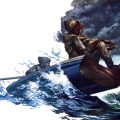Muddlers Made Easy

The basic shape of the Muddler Minnow can be adapted to create patterns of any colors and made of any materials.
THE ORIGINAL Muddler Minnow was actually a very simple affair. Minnesota angler Don Gapen invented the pattern back in the 1930s to tempt the big brookies of Ontario’s Nipigon River, and it has been undergoing constant tweaking, revisions, and reinventions ever since. For example, digging through some fly-tying books from the early 1960s — not long after Joe Brooks popularized the pattern in the pages of Field & Stream — we can find examples of Muddlers that consist of nothing more than a tinsel-body streamer with a short bucktail tail and wing, and a single untrimmed clump of deer hair for a head.
Thanks mostly to the pattern’s first champion, Dan Bailey, the Muddler eventually evolved to its present, “accepted” pattern involving a turkey-quill tail, matched turkey-slip wing, tinsel underbody, and a rather dense spun-and-clipped deer-hair head. And over several decades, the Muddler also spawned dozens of offshoot patterns designed to fool all kinds of fish in all kinds of water. Everything from Marabou Muddlers to Spuddlers to Tarpon Muddlers and Snake Flies for saltwater use trace their ancestry back to the original Muddler Minnow.
At each step of the evolutionary path, the complexity of the pattern increased. And (usually) the density of the deer-hair head increased as well. The original pattern with its sparse head is long forgotten, and few fly fishers would pay money for one. Indeed, they demand Muddlers with tightly packed heads. (Which is interesting since the Muddler is supposed to imitate the bottom-dwelling sculpin, and a Muddler with a tight head often can’t get anywhere near the bottom.)
Still, the deer-hair head is a constant of Muddler designs and a constant headache for tiers. Most tying problems stem from two things: Failure to properly plan the fly, and not knowing how to work with deer hair. Both of these are easy to remedy.
Proper Planning
In its modern incarnation, the Muddler is really two flies on one hook. The back end of the Muddler is nothing more than a streamer fly. The deer-hair head is then added in front of the streamer portion. Failing to recognize the two-fly nature of the pattern leads to poor planning in tying the complete fly. All too often, tiers complete a beautiful back end and find themselves with too little hook shank remaining to complete the head. But if you break the tying process into two separate steps — the streamer rear half and the deer-hair head — you can more easily figure out how much hook shank you’ll be leaving empty for the head.
However, that still invites the question, How do you know how much shank to leave blank? A good general rule of thumb is to leave around a fifth of the shank empty when you finish the streamer portion. Your own tastes may vary, and individual Muddler offshoot patterns may call for more or less of a head. But leaving the front 20 percent of the shank for the head is a good place to start.
Picking Hairs
An inability to work comfortably with deer hair leads to the other major problems of would-be Muddler tiers. One of the potential pitfalls is that it’s so easy to get the wrong hair for the job. Unless you have spent a lot of time working with deer hair, it’s hard to know what you’re looking for, or even what you’re looking at.
And therein lies the big secret of tying Muddlers or any other deer-hair pattern: looking at and feeling the hair before you buy it. I know many very good fly tiers who treat deer hair as if it were made of plastic. These guys will spend hours pawing through every dry-fly neck in the shop — bending hackles,counting barbs, and examining webbing with a magnifying loupe — yet they will just grab a package of deer hair and toss it on the counter without even opening it. It’s no surprise that most of the hair they wind up with is of poor quality and extremely difficult to work with.
What they (and you) should be doing is opening the package and taking out the hair patch. Here’s what you’re looking for in quality deer hair:
Tanned Hide: If possible, buy hair that comes on a tanned (soft and pliable) hide instead of a Borax-cured hide. Tanning damages the hair less than Borax treatment, which tends to make the hair dry and brittle. A tanned hide is also easier to work with.
Hair Shafts vs. Tips: Whether you’re tying 3/0 bass bugs or size 12 Muddlers, you want hair that has straight shafts and very small tips. The individual hairs should have constant diameters for 95 percent or more of their length, with tips making up 5 percent or less.
Softer is Better: Good hair feels soft and supple. Most hair that hasn’t been bleached or dyed feels this way and will spin quite well. However, bleaching and dying can really destroy deer hair if it’s not done properly. The hair becomes dry, stiff, and brittle; it may not spin or flare. In some cases, the hair may even deteriorate to the point where even light tension causes the thread to cut right through the hair.
For all but the smallest Muddlers, “regular” deer hair works well. You don’t want hair that’s too fine or too coarse. However, if you’re forced to choose one or the other,
go with too fine. You can always stack in more hair to fill a Muddler head, and fine hair makes for a smoother, better-looking head.
If you want to tie tiny Muddlers, look into getting a small patch of the short deer hair meant for Comparaduns and similar dry-fly patterns. The same rules apply to choosing patches of this short hair as when selecting “regular” hair. However, a good Comparadun patch will be much finer than regular hair, and it will tend to have longer tips — as much as 10 percent of the overall hair length will be tip.
Hair Management
For the purposes of this article, we’ll assume you know how to tie a regular streamer. That, after all, is what the back end of a Muddler is. So start your Muddler by tying a Black-Nose Dace or some similar streamer on the rear four-fifths of the hook shank. Leave the front fifth bare.
With the back end tied, it’s time to apply the hair that will become the Muddler’s head. And this is where things start to get tricky. Or not. The classic method of making Muddler heads is to spin the first dump of hair into place. But spinning deer hair takes some practice, and many tiers just never quite get the hang of it. You can make your life a lot easier by stacking the hair in place.
Stacking is nothing more than holding the clump of hair on top of the hook with the hairs parallel to the hook shank. Make two loose wraps of thread around the hair, and then pull the thread straight down from the hook shank. Hold the hair steady as you tighten the thread — don’t let it slip around the hook. If the hair with which you’re working is of even reasonable quality, you’ll find that it doesn’t take a lot of tension on the thread to make the hair flare. (In fact, all the Muddler examples in this article were tied with 8/0 Uni-Thread.)
Once the hair flares, make another two or three wraps of thread over the exact same spot as the first two. Use your fingers to stroke all the flared hairs back over the hook, and then bring the thread up through the hairs on the bottom of the hook. Make two tight wraps of thread right at the base of the hair; then put two half-hitch knots on top of those two wraps.
Except when you’re tying really big Muddlers (say, size 1 and up), you should need only one more clump of hair to fill out the fly’s head. You can spin this into place, or you can stack it in place just like you did the first clump. If you stack it, use the same technique I just described. Just make sure you stroke back all the hairs from the first clump before you stack in the next one. After that clump is in place, tie off the thread with either some half-hitches or a whip finish.
Once the hair is set, all that’s left is trimming. You can use a double-edge razor (my personal favorite), or you can trim the head with a pair of small scissors. Use scissors that have serrated-edge blades. Those grip the hair before cutting it, whereas plain-edge scissors tend to push the hair before cutting it, which makes it very difficult to get the smooth, even head shape you want.
Tying good Muddler Minnows is not difficult. If you treat the Muddler as two flies on a single hook, with the back end being a streamer and the front end being nothing more than two or three dumps of stacked deer hair, you’ll find the Muddler and its variants no more difficult than any other fly.











